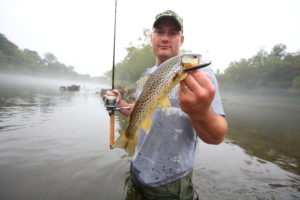BY Kevin Kelly
Anglers treasure the fall months in Kentucky.
The shortening periods of daylight and the cooler, drier air bring welcome relief from summer and bring on the fall colors. It’s during this time of transition that some of the best fishing of the year can be had.

For trout anglers, fall offers a smorgasbord of opportunities.
The Kentucky Department of Fish and Wildlife Resources helps through widespread stocking, and at no time is this practice on display more than in the coming weeks. October sees trout stocked in more than two dozen streams, almost a dozen tailwaters and 14 lakes. Half of the 40 lakes enrolled in the Fishing in Neighborhoods (FINs) program are stocked in October while the other half receives trout in November.
“Because water temperatures generally become too warm to support trout in summer, we haven’t stocked a lot of these places since spring,” said Dave Dreves, assistant fisheries division director for Kentucky Fish and Wildlife. “If you like to fish for trout, the season is coming. It will be a good time to get out and take advantage of newly stocked fish.”
The first of October starts a catch-and-release trout season for 15 streams – most located in the eastern half of the state – that continues through March. Swift Camp Creek in Wolfe County is the lone exception as its catch-and-release season extends through May.
“The concept behind the catch-and-release season is to conserve those fish so they’re not caught out so quickly,” Dreves said. “It’s very popular with anglers.”
Only artificial lures may be used for trout in these streams. Organic baits such as PowerBait, corn, cheese or salmon eggs, and live baits like worms or minnows may not be used.
In general, small in-line spinners and crankbaits fished with spinning gear on 4-pound line are good bets for trout in flowing waters.
“They always seem to do the trick for me,” said John Williams, southeastern fisheries district biologist with Kentucky Fish and Wildlife. “Other people throw spoons and thin-bodied suspending jerkbaits.”
Fly anglers should consider carrying smaller streamers and midge patterns as well as stonefly and egg imitations.
To help ensure the survival of a trout that’s been caught, handle it as gently and as little as possible.
“Try to avoid doing anything that might wipe off their protective slime,” Dreves said. “It’s good if you can take the fish off without using a net. Unhook it in the water using your hook extractor tool. If you have to take it out of the water, it’s better if you handle it with wet hands and don’t grab it too tightly or use a soft mesh landing net. If you can avoid it, don’t play them for a long amount of time. Use a heavy enough tippet that you can land the fish in a reasonable amount of time. The more you play it the more you have a chance of wearing that fish down to the point it may not survive.”
Tailwaters also offer good opportunities for rainbow and, in some instances, brown trout but anglers should first check with the appropriate agency for the water release and generation schedules for the tailwater they’re planning to fish.
John Hast is a wildlife biologist with Kentucky Fish and Wildlife and an avid fly angler. The Dix River below Herrington Dam is one of his favorite fall haunts for trout.
“We’ve done well on the Dix River in October running a zebra midge beneath a strike indicator. If they’re not eating that, you’re not in the right spot,” Hast said.
“As far as the Cumberland tailwater, the Hare’s Ear nymph and Copper John are the gold standard. Some anglers run a zebra midge off those under a strike indicator.”
Fisheries Division staff sampled the Cumberland River below Wolf Creek Dam twice this summer to monitor the condition of the fish in it.
“The first time we did it we did a little bit better on numbers, but the tailwater is always good,” Williams said. “If you want to go catch a trout, go to the tailwater.”
While there, consider visiting the new-look Hatchery Creek. Recent reports indicate rainbow, brown and brook trout are utilizing the creek. The upper section of the creek has a five trout daily creel limit. The lower section of Hatchery Creek – delineated by a migration barrier and signage – is open for catch and release only for all trout species and only artificial baits can be used.
All anglers fishing the Cumberland River from the Wolf Creek Dam downstream to the Tennessee state line, including tributary streams up to the first riffle and all of Hatchery Creek, must possess a trout permit. The permit is included in the resident Sportsman’s and Senior or Disabled licenses. Elsewhere in the state, anglers who are required to have a fishing license and intend to keep trout must have a trout permit.
Additional information about trout fishing in Kentucky is available on the department’s website at fw.ky.gov and in the annual Kentucky Fishing and Boating Guide, which is available online and wherever licenses are sold.
Author Kevin Kelly is a staff writer for Kentucky Afield magazine, the official publication of the Kentucky Department of Fish and Wildlife Resources. Get the latest from Kevin and the entire Kentucky Afield staff by following them on Twitter: @kyafield.


Be the first to comment